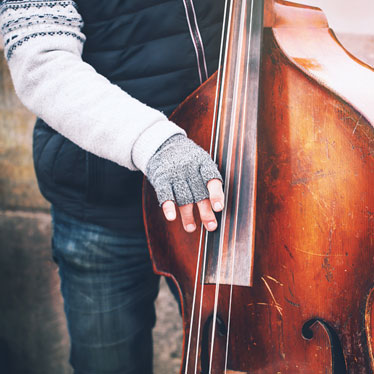What to Wear For A Winter Outdoor Performance

While audience members have the luxury of bundling up to their hearts’ content, musicians playing outdoors aren’t so lucky during the winter months. You need to be strategic about the clothes you select to remain warm enough – but nimble enough – to play your instrument well.
Think Thin Layers
We’re used to thinking that bigger (or thicker) is better when it comes to staying warm. However, outdoor enthusiasts know that’s not the case when you want to move with ease. Take their advice and plan your winter concert wear by utilizing winter-specific fabrics in thin layers. This will keep you warm and more-or-less waterproof while allowing you to move more freely – a particular help if you’re part of a marching band or plan to move from corner to corner as you busk.
The three layers to think about include:
- Base layer. This layer is the first one you put on after your underwear. It’s designed to wick sweat off your skin, so it doesn’t chill. Long johns are the most famous version, or a base winter layer, and these days they come in cold-tech materials that provide exceptional warmth.
- Middle layer. This layer provides the bulk of your insulation, keeping the body warm by retaining your body’s natural heat. Fleece and similar materials are often a favorite for this layer as they’re soft, comfortable and effective.
- Outer layer. The shell layer is designed to protect you from the elements at work – such as rain, wind or snow. And, since shells typically don’t breathe well, they perpetuate the preservation of heat retained by the middle, insulating layer.
We recommend purchasing high-quality versions of the above items. While brand new clothing is often expensive, you can peruse online sales or outlet options to save money, or check out sites such as rei.com’s used option, or geartrade.com to find great deals.
Leggings or long johns
Leggings and long johns are very thin and easily worn under pants, dresses or skirts. Look for fleece-lined or flannel-lined options for additional insulation and warmth value. This base layer may be the most important part of your outdoor performance wear if you’re expected to don more “normal” concert attire on top. Here’s an informative article from REI on How to Choose Base Layers.
Socks designed for winter climbing, hiking or hunting
Most of the outdoor socks worn by climbers, hikers or hunters are made from merino wool. These soft socks are pricier than normal, but a single pair will last you a very long time if you save it for your outdoor performance gigs. While these are found easily online, we recommend shopping for them in person, especially if you have sock-sensitive feet. They vary quite a bit in fit and style, so it’s worth seeing what they feel like before investing.
Look for outdoor socks that go up and over the calf to maximize warmth. If your feet run cold, opt for thicker pairs or plan to double up.
A sleek winter hat and scarf
The Army Field Manual claims that as much as 40% to 45% of our body heat is lost through our head. This makes a sleek, high-performing hat a must. It may be worth the music program budgeting for a matching set of high-quality fleece or knit hats in your school’s colors that can be checked-out to students seasonally (one hat per person to avoid a lice breakout) and laundered once they’re returned.
These fleece, Columbia beanies come in a range of colors and are competitively priced – plus their double-layer design puts them in the ultra-warm category.
Similarly, a scarf helps to keep your jugular vein warm – and that goes a long way towards keeping you warm all over.
Fingerless gloves
If you can play your instruments with full-fingered gloves, more power to you. Most musicians, however, find it easier to wear fingerless gloves. These go a long way towards keeping the hands warm while allowing the fingers to play. Look for styles that have a “mitten-style” flap that wrap over the fingers during breaks or long periods when you don’t play.
Read, How to Keep Your Fingers Warm When Playing Outside, for more winter comfort tips.
Water/Windproof shell
When you’ve paid attention to the first two layers, you can probably get by with a thin- or medium-weight shell to block the wind and any rain or snow moisture. If you tend to run cold more than hot, invest a little more in a shell that includes an additional layer of insulation.
High-Quality instrument cases
Don’t forget, your instrument needs protection from the warmth and cold too. Keep your instrument inside its case when you’re not playing, preferably sheltered from the elements. Click Here to view reasonably-priced violin cases from Revelle and read, 9 Tips to Care For Your Instrument in the Winter, for more along those lines.
With these essential winter layers taken care of, you can feel, look, and play your best – even when performing outdoors during the winter months.


